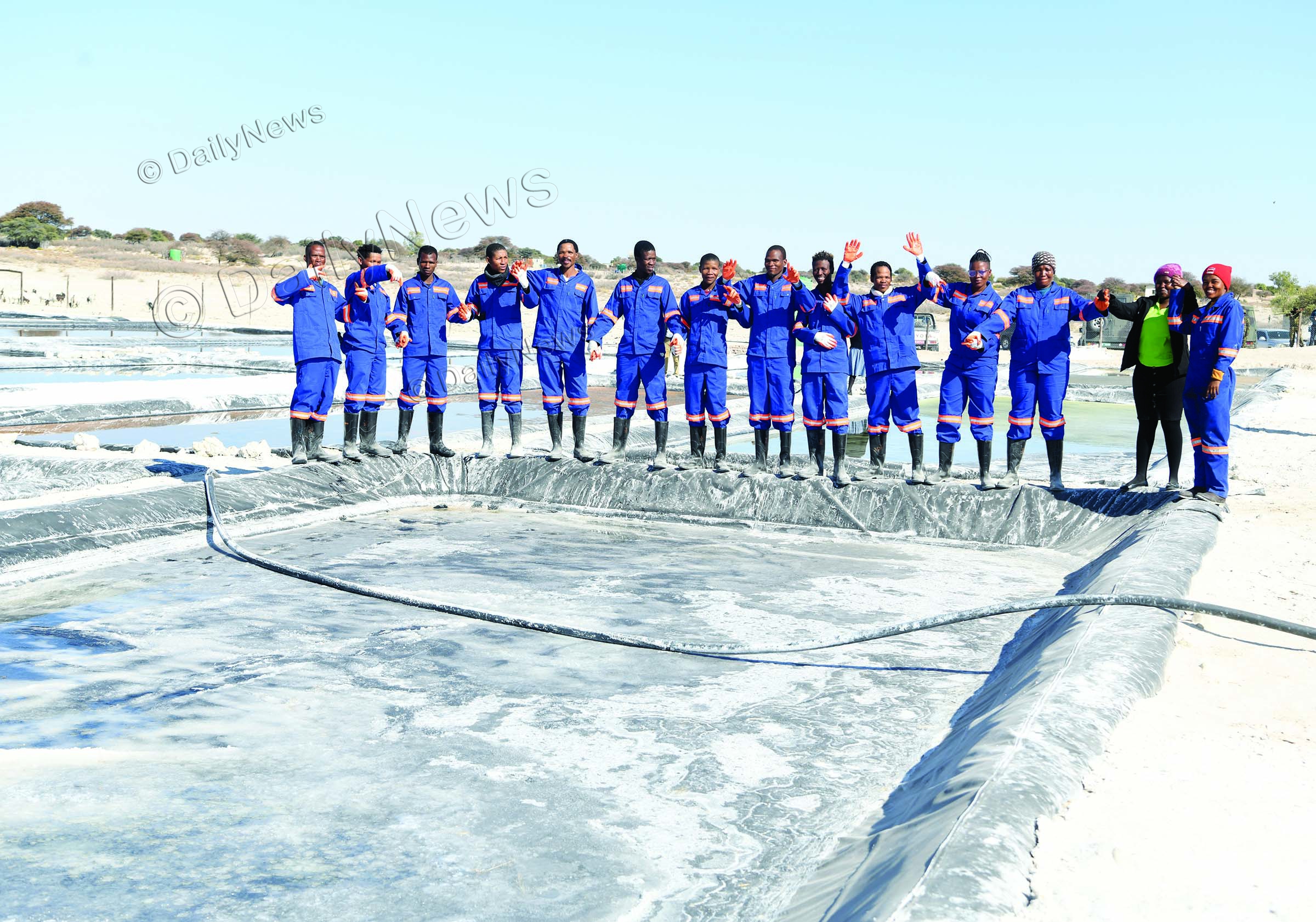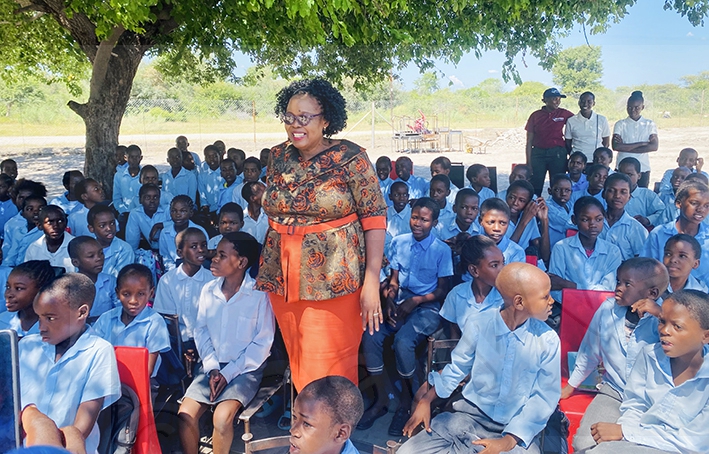Zutshwa Salt Mine grows in leaps and bounds
15 Sep 2024
Located at Zutshwa settlement in the Kgalagadi North District, Zutshwa Salt Mine is undergoing an expansion that will see it grow in terms of production and personnel.
The mine is owned by Qhaa Qhing Conservation Trust, a community trust of the people of Zutshwa. The trust is also in charge of the KD2 conservation area.
Narrating how the mine came into being, its general manager, Mr David Tlhage said it all started in the late 80s to by the German missionaries in their quest to look for potable water for the people of Zutshwa.
The exploration was performed by the missionaries who were present in the area together with the management of Rural Industries Innovation Centre (RIIC) in Kanye.
“They drilled some boreholes and the outcome was a salt concentrated water (brine) that was not even safe for animals to drink. After realising such, they distilled it to separate the drinking water from salt. Around 1994 they decided to transfer the running and management of the mine to Zutshwa community,” he said.
However, Mr Tlhage said due to lack of management skills, the project did badly until it collapsed in 2008. He said government resuscitated the Zutshwa Salt Mine project in 2015 and that was when crystalisation ponds were constructed. The mining process, according to Mr Tlhage, involves getting the brine from underground and processing it.
“We are currently expanding our production operations by constructing bigger concentration/holding ponds and crystalisation ponds, of 50m by 70m with a 1.5m depth and 40m by 60m with a 30cm depth respectively. Upon completion, we are going to have eight crystalisation ponds and two concentration ponds. At the moment we have 44 crystalisation ponds, which are smaller in size. Following a benchmarking exercise at Sowa mine, it was recommended that we expand our crystalisation ponds in order to speed the evaporation process,” he said.
Mr Tlhage said they were assisted by Local Enterprise Authority (LEA) with a business model and coming up with a business plan to enable them to request for funding. He further mentioned that they managed to get funding from different stakeholders to fund different components of the project.
Furthermore, said SADC funded the project to a tune of P2.2 million for the expansion of a perimeter fence, which is already complete, construction of one concentration pond and two crystalisation ponds. The construction of the ponds are ongoing and are anticipated to be complete by end of September.
“They also bought us a concrete dumper, which is used to carry salt, after drying, into the warehouse. Previously we used wheel burrows to carry the salt and it was labour-intensive. Still under the SADC fund, the expansion of the warehouse is ongoing. They also bought us 25 000 branded packaging bags.”
The SADC funding is managed by BirdLife Botswana.
Another funding is through the Rural Development Council (RDC), to the tune of P2 million. The funding is managed by LEA and it covers the construction of eight crystalisation ponds and one concentration pond. So far, three boreholes of between six and seven cubic metre-yield of brine have been drilled. Mr Tlhage said they are currently waiting for connections and reticulation of water from the new boreholes to the ponds.
Under the United Nations Development Programme (UNDP), the mine received a fund for the expansion exercise to an amount of P1.7 million and through the fund, Mr Tlhage said, they bought a front loader machine and were in the process of procuring concrete mixer machine.
“The concrete mixer will help during the packaging stage where we have to add iodine. Other items to be procured through the UNDP fund include two digital scales for weighing packaged bags, and a booster pump,” he added.
Mr Tlhage said in the recent past, they have been selling to walk-in customers and Livestock feeds manufacturing companies, Botswana Agricultural Marketing Board (BAMB) and Supa Feeds being the main customers.
“On August 2024, we signed a three-year contract with BAMB to sell exclusively to them and that means 100 per cent of our yield will go to BAMB. We used to encounter instances whereby we will produce more and sell less, and now with this contract, we are definite about our product sales,” he said.
The mine chief said their small operation was at the moment seasonal. During winter we make 1 000 bags per month while in summer we make an average of 1 600 bags per month. Our deal with BAMB is to do at least 4 000x50kg bags per month for a period of three years and with the new expansions, we will be able to do that,” he added.
Besides Ipelegeng, the mine serves as an employment base for Zutshwa community. Mr Tlhage said for the mine to cover many people, they are employed on a six month-rotational period. He said currently the mine had six labourers, 15 males and five females, “The work here is too laborious, that is why we have lesser females,” he explained.
The supervisor is the only one employed on permanent base while a driver, accountant, and general manager are on contracts base.
Night-watchmen alternate. With the new BAMB contract and the expansion of the mine, Mr Tlhage said, increase in personnel was also imminent.
Besides provision of employment to Zutshwa community, Mr Tlhage said the intention is to do some community projects in the village as well as sponsoring some members of the community to study courses in line with the operations of the Zutshwa Salt Mine.
Explaining the salt mining process in brief, Mr Tlhage said it involves pumping of brine from the boreholes to the concentration ponds.
After a few days of evaporation, depending on the weather, the remaining concentrated water would then be pumped into the crystalisation pond.
Mr Tlhage added: “Because of the high temperatures during summer, salt formation takes three to five days while during winter crystalisation takes five to seven days.
During this stage we make sure that the salt does not dry completely for easier harvesting. We then harvest the salt from the pond and leave it to dry before we can take it to the warehouse for packaging.”
He explained that during packaging, iodine is added to the salt to get rid of germs that could have found their way into the product during the mining process. We use non-corrosive equipment for harvesting and currently we are only producing for livestock consumption. Ends
Source : BOPA
Author : Malebogo Gaolebogwe
Location : Kanye
Event : Interview
Date : 15 Sep 2024







